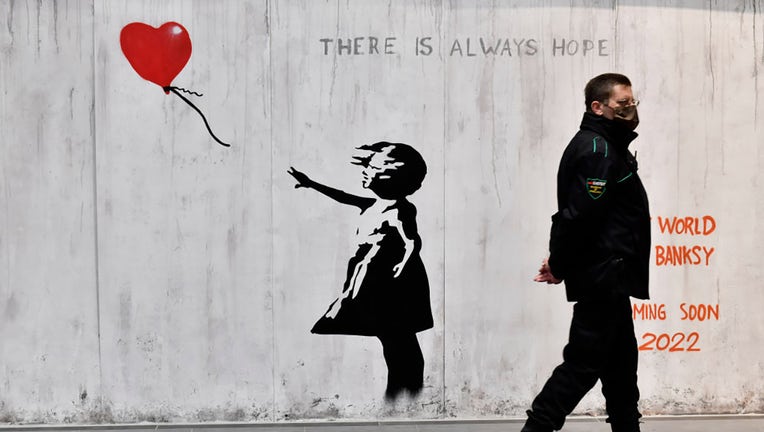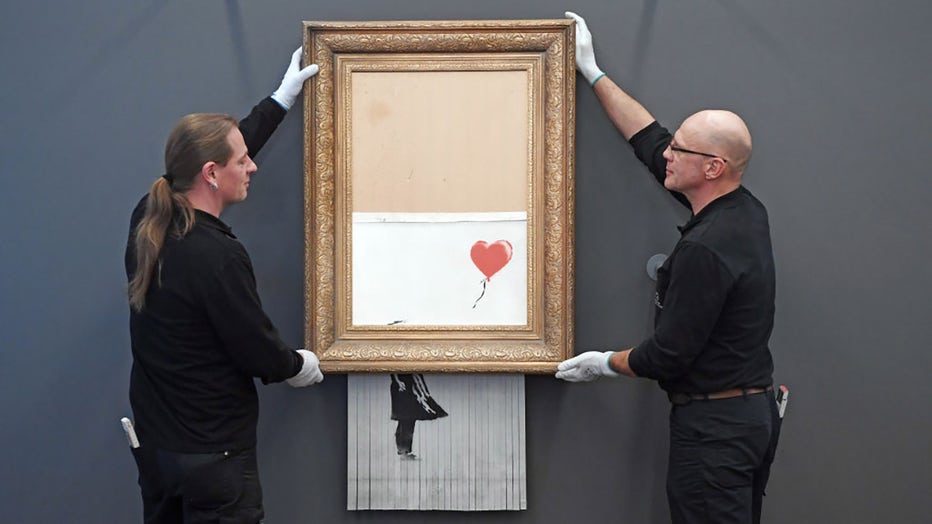Banksy's real name? Street artist appears to reveal identity in lost BBC interview

FILE - A man walks near a Banksy artwork during the "The World of Banksy" Art Exhibition at Porta Nuova Railway Station on Feb. 24, 2022, in Turin, Italy. (Photo by Stefano Guidi/Getty Images)
LONDON - Who is Banksy? The anonymity of the famous graffiti artist has been an enduring part of his brand since the artist rose to fame in the late 1990s, but a recently-unearthed BBC interview may have revealed his true identity.
Banksy, who has never confirmed his full identity, began his career spray-painting buildings in Bristol, England, and has become one of the world’s best-known contemporary artists through his satirical images in the instantly-recognizable stencil technique.
The BBC reported this week that it discovered a 2003 interview recording between Banksy and former BBC arts correspondent Nigel Wrench. The artist, in his 20s at the time, spoke with Wrench to mark the opening of his "Turf War" show in east London.
An edited version of the interview aired that summer on BBC radio, but not all of the material was used, according to the outlet. The edited version of the interview was also later used as part of the BBC podcast series "The Banksy Story," released in July.
Wrench was listening to "The Banksy Story" podcast, and said it prompted him to recover his full original interview on a mini-disc in his house.
In the 2003 recording, Wrench asks him if his name is "Robert Banks," and the artist replies: "It's Robbie."
The enduring mystery of Banksy
Banksy rarely gives interviews, and his mysterious identity has only sparked more speculation over who he could be.
In another early interview with The Guardian in 2003, the outlet described him as "white, 28, scruffy casual - jeans, T-shirt, a silver tooth, silver chain and silver earring." Guardian writer Simon Hattenstone wrote that he looked "like a cross between Jimmy Nail and Mike Skinner of the Streets."
Banksy’s work often centers on anti-authority and political themes, satirically critiquing things like war, capitalism, consumerism, and society at large. Images include two male police officers kissing, armed riot police with yellow smiley faces and a chimpanzee with a sign bearing the words, "Laugh now, but one day I’ll be in charge."
Viral Banksy artwork 'Love is in the Bin' breaks world record at auction
The Banksy art piece, "Love is in the Bin," which originally shredded itself upon being sold the first time, was just sold again at Sotheby's for a world record of nearly $22 million. The name of the buyer was not immediately released.
Several of his works have sold for multiple millions at auction. In 2021, a Banksy mural honoring Britain’s health workers, first painted on a hospital wall, sold for 16.8 million pounds ($23.2 million) at a Christie’s auction.
In 2018, one of his pieces known as "Girl With Balloon" sold for $1.4 million at a Sotheby’s auction. But just as the female European buyer made the winning bid, a hidden shredder embedded in the frame by Banksy whirred to life, leaving half the canvas hanging from the frame in strips.

The shredded Banksy painting "Love is in the Bin" is hung in the Frieder Burda Museum in 2019. (Photo by Uli Deck/picture alliance via Getty Images)
Three years later, the self-shredded work fetched $25.4 million – close to 20 times its pre-shredded price.
While the art world may never know Banksy’s true identity, many argue the mystery itself is essential to understanding his work.
As London art dealer MyArtBroker notes, anonymity is a key part of his allure and greatly affects his work.
"The ultimate irony remains that Banksy's anonymity makes his work all the more dramatic, captivating and - ultimately - valuable in the art world he mocks," Syer wrote. "The secret has become too important to his work, and the real question is: if Banksy came forward and revealed his real identity, would we even believe him?"
This story was reported from Cincinnati. The Associated Press contributed.

